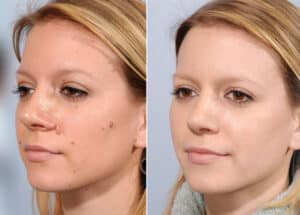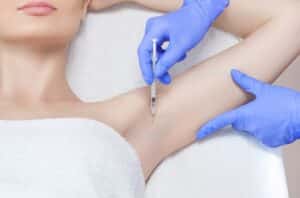Understanding Morpheus8 Treatment
Treatment Basics
Morpheus8 combines microneedling with radiofrequency. This dual approach remodels both skin and fat. It’s a cutting-edge method that goes beyond surface-level treatments, involving injections, topical numbing with topical lidocaine, and a procedure.
This technique, involving injections and topical numbing with topical lidocaine, specifically targets the subdermal layers of the skin in the treatment area. It does so to achieve effective body remodeling and skin tightening. The process stimulates collagen production, vital for youthful skin.
Versatility
Morpheus8 stands out for its versatility. It treats various areas of the body, from face to abdomen, as a skin treatment procedure, often involving a consultant ENT surgeon and numbing. This flexibility makes it superior to traditional treatments.
It can address concerns like wrinkles, acne scars, and sagging skin. Its ability to target different depths in the area allows for customized treatment plans, with numbing as a common side effect, according to Mr. Bast. This adaptability ensures that almost anyone can benefit from Morpheus8, a skin treatment that Mr. Bast recommends for numbing the area.
Benefits Over Traditional Treatments
One of Morpheus8’s biggest advantages, as a skin treatment in the area, is its minimal downtime. Unlike more invasive procedures, patients can return to daily activities quickly.
Its precision also reduces the risk of side effects common in other treatments. Patients experience less discomfort and quicker recovery times. Furthermore, results are often visible after just one session, improving over time.
Pain Perception During Morpheus8
Pain Levels
Pain perception varies widely among individuals undergoing Morpheus8. Generally, this treatment is less painful than more invasive cosmetic procedures. The sensation can be likened to a series of quick, tiny pinches on the skin’s surface.
Patients often describe the feeling as manageable, especially with proper pain management techniques in place.
Numbing Methods
Topical anesthesia plays a crucial role in minimizing discomfort during Morpheus8 sessions. Applied 30 to 60 minutes before treatment, it significantly reduces pain sensations.
For those with lower pain thresholds, lidocaine injections offer deeper numbing. This method ensures an even more comfortable experience for sensitive areas or patients.
Pain Management
Discussing pain management options with your provider is important. They can tailor approaches based on your pain tolerance and previous experiences with cosmetic treatments.
Options might include varying the depth of needle penetration or adjusting the intensity of treatment to ensure comfort while achieving desired results.
Tolerance Assessment
Considering a single Morpheus8 session initially is wise for those unsure about their pain threshold. This approach allows individuals to gauge their own sensitivity and decide on further treatments accordingly.
It also provides an opportunity to discuss any discomfort experienced with the provider, potentially adjusting future sessions for better tolerability.
Common Side Effects Explained
Soreness
After undergoing Morpheus8 treatment, patients often experience soreness in the treated areas. This discomfort is a normal reaction as the skin begins to heal and regenerate. Typically, this soreness fades within a few days.
It’s crucial for patients to avoid touching or applying pressure to these sensitive areas. Doing so can aggravate the soreness and potentially prolong recovery.
Swelling
Mild swelling is another common side effect following Morpheus8 procedures. This swelling is your body’s way of protecting and healing the treated regions.
To minimize swelling, patients are advised to follow aftercare instructions closely. This includes using cold compresses and keeping the head elevated when lying down. With proper care, most swelling subsides within a week.
Healing Timeline
Understanding the healing process is essential for managing expectations post-Morpheus8 treatment. While redness and mild swelling are immediate reactions, they are also temporary.
The peak of these side effects usually occurs within the first few days post-treatment. However, they begin to diminish significantly after that period. Most patients see a noticeable improvement in their skin’s condition within a week, with full healing taking place over several weeks.
Safety Measures and Concerns
Equipment Safety
Morpheus8 utilizes industry-leading technology. This ensures treatments are both effective and safe. The equipment is designed with client safety at the forefront.
Professionals undergo thorough training before operating the device. They learn about its settings and how to adjust them based on individual needs. This minimizes risks of harm or discomfort.
Professional Expertise
The qualifications of professionals performing Morpheus8 treatments are critical. Only trained experts should handle the equipment.
They possess a deep understanding of skin concerns and sensitivity. Their expertise ensures that each session is tailored to minimize discomfort and maximize safety.
Pre-Treatment Care
Pre-treatment consultations play a vital role in ensuring patient suitability. During these sessions, professionals assess skin type, areas of concern, and sensitivity levels.
Patients receive advice on how to prepare their skin for treatment. This includes avoiding sun exposure and using sunscreen to prevent irritation or scabs.
Post-Treatment Attention
After Morpheus8, some patients might experience mild discomfort or sensitivity. Proper post-treatment care is essential for healing and reducing any potential irritation.
Professionals provide detailed guidance on how to care for treated areas. They stress the importance of protecting sensitive skin from the sun to avoid further complications.
Aftercare Essentials Post-Treatment
Skincare Routine
After a Morpheus8 session, choosing the right skincare products is crucial. It’s essential to use a gentle face wash that won’t irritate the treated areas. Harsh chemicals can delay healing, so opt for products designed for sensitive skin.
Applying a high-quality moisturizer helps with rejuvenation. Look for ingredients like hyaluronic acid that provide deep hydration without clogging pores.

Sun Protection
The importance of sun protection cannot be overstated. The treated skin is more vulnerable to UV damage, making high SPF sunscreen a must-have in your daily routine. Reapply every two hours when outdoors to ensure continuous protection.
Avoid direct sunlight as much as possible during peak hours. Wearing hats and seeking shade can further shield your skin from harmful rays.
Professional Guidance
Following up with your consultant ENT surgeon or skincare professional is key. They can recommend specific aftercare products, like topical lidocaine, to ease any discomfort.
Their advice on when it’s safe to resume using makeup or certain face washes ensures you don’t compromise your results. Trusting their expertise leads to optimal recovery and outcomes.
Morpheus8 Versus Micro-Needling
Skin Rejuvenation
Morpheus8 takes skin rejuvenation to a new level by combining microneedling with radiofrequency energy. This dual-action approach goes deeper than traditional microneedling, targeting the subdermal layers of skin. It stimulates collagen production more effectively.
Traditional microneedling works well for surface-level skin issues. But Morpheus8’s added radiofrequency reaches deeper, offering enhanced skin tightening and rejuvenation. This makes it ideal for those seeking significant improvements without resorting to invasive surgery.
Tissue Remodeling
The combination found in Morpheus8 allows for deeper tissue remodeling. It addresses not just the surface but also the underlying structures of the skin. This is crucial for achieving long-lasting results and tackling more severe signs of aging.
Microneedling alone can improve skin texture and appearance. However, Morpheus8’s ability to coagulate fat means it can also contour the face and body subtly. This isn’t something traditional microneedling can claim.
Broad Issues Range
Morpheus8 shines in treating a broader range of skin issues compared to microneedling alone. It’s particularly effective against pronounced lines, wrinkles, and sagging skin. The device’s precision allows it to target specific areas needing improvement, making it versatile across different skin types and concerns.
Patients with concerns about hyperpigmentation or acne scars find Morpheus8 beneficial too. The treatment promotes healthier-looking skin by encouraging natural healing processes deep within the dermis.
Treatment Effectiveness and Results
Expected Outcomes
Patients seeking Morpheus8 treatments can anticipate a noticeable improvement in their skin’s texture and appearance. This innovative skin treatment harnesses the power of radiofrequency energy combined with microneedling to remodel the skin deeply. It effectively targets wrinkles, sagging skin, and even acne scars, offering a comprehensive solution for various skin conditions.
The process stimulates collagen production, leading to firmer, smoother, and more youthful-looking skin. Most individuals report seeing significant changes after just one session, although optimal results typically require a series of treatments.
Realistic Expectations
Setting realistic expectations is crucial for anyone considering Morpheus8. While some patients may experience immediate improvements, the full effects of the treatment unfold over time. The number of sessions needed varies based on individual skin conditions and desired outcomes.
A certified provider can offer guidance on how many treatments will yield the best results. They also advise on maintaining those results through proper skincare products and routine follow-ups. It’s important to understand that while Morpheus8 offers long-lasting effects, they are not permanent. Skin continues to age naturally.
Transformative Effects
Testimonials from those who have undergone Morpheus8 treatments speak volumes about its efficacy. Many describe it as a comfortable treatment experience that has significantly improved their skin’s texture and overall appearance.
Clients with longstanding issues like acne scarring or deep wrinkles often share before-and-after photos showcasing dramatic transformations. These real-life examples highlight Morpheus8’s power to not just enhance appearance but also boost confidence.
Closing Thoughts
Morpheus8 treatment offers a revolutionary approach to skin rejuvenation, blending the benefits of micro-needling with radiofrequency energy for impactful results. Your concerns about pain are valid, but with proper safety measures and aftercare, discomfort is manageable and temporary. The comparison between Morpheus8 and traditional micro-needling highlights Morpheus8’s superior effectiveness in achieving desired outcomes. Remember, the success of your treatment heavily relies on following aftercare instructions and choosing a qualified professional for the procedure.
Diving into Morpheus8 opens the door to not just enhanced skin appearance but also boosted confidence. If you’re eyeing lasting improvements in skin texture and firmness, taking the plunge with Morpheus8 could be your game-changer. Ready to transform your skin? Seek advice from a trusted aesthetic expert and explore how Morpheus8 can tailor-fit your needs. Your journey to radiant, youthful skin starts now.
Frequently Asked Questions
Does Morpheus8 treatment hurt?
Morpheus8 involves minimal discomfort. Most patients report feeling slight pressure and warmth. Pain perception varies, but overall, it’s well-tolerated with numbing cream.
What are common side effects of Morpheus8?
Common side effects include mild redness, swelling, and sensitivity at the treatment site. These typically subside within a few days.
How safe is Morpheus8?
Morpheus8 is considered safe when performed by a qualified professional. It incorporates safety measures to minimize risks and ensure patient comfort.
What should I do after Morpheus8 treatment?
Aftercare includes keeping the area clean, avoiding direct sun exposure, and applying recommended products to aid healing.
How does Morpheus8 compare to micro-needling?
Morpheus8 combines micro-needling with radiofrequency energy for deeper tissue remodeling, offering enhanced results compared to traditional micro-needling alone.
How effective is Morpheus8?
Morpheus8 effectively tightens skin, reduces wrinkles, and improves texture. Results vary but are generally noticeable within a few weeks post-treatment, improving over time.











